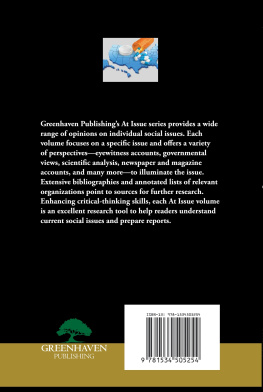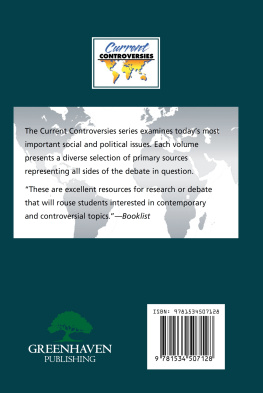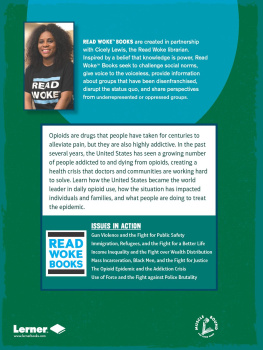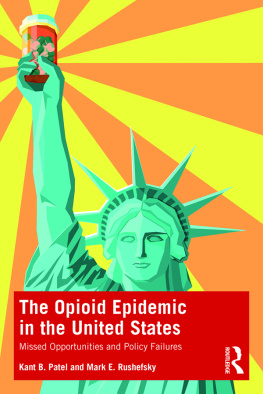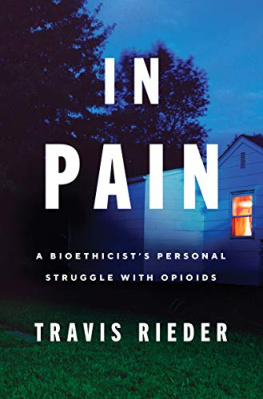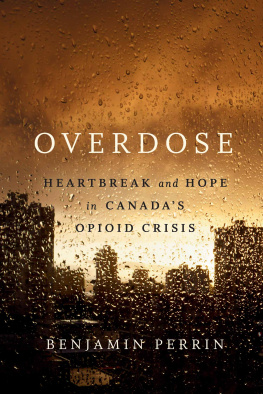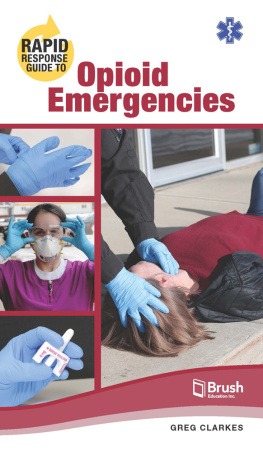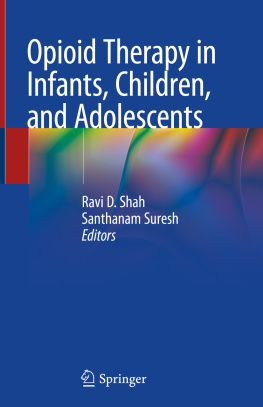

The Opioid Crisis
Other Books in the At Issue Series
Americas Infrastructure
Celebrities in Politics
Ethical Pet Ownership
Male Privilege
Political Corruption
Presentism
Public Outrage and Protest
The Role of Religion in Public Policy
Troll Factories
Vaping
Wrongful Conviction and Exoneration
Published in 2020 by Greenhaven Publishing, LLC
353 3rd Avenue, Suite 255, New York, NY 10010
Copyright 2020 by Greenhaven Publishing, LLC
First Edition
All rights reserved. No part of this book may be reproduced in any form
without permission in writing from the publisher, except by a reviewer.
Articles in Greenhaven Publishing anthologies are often edited for length to meet page requirements. In addition, original titles of these works are changed to clearly present the main thesis and to explicitly indicate the authors opinion. Every effort is made to ensure that Greenhaven Publishing accurately reflects the original intent of the authors. Every effort has been made to trace the owners of the copyrighted material.
Cover image: Billion Photos/Shutterstock.com
Library of Congress Cataloging-in-Publication Data
Names: Cherenfant, Sabine, editor.
Title: The opioid crisis / Sabine Cherenfant, book editor [compiling editor].
Other titles: At issue
Description: First edition. | New York: Greenhaven Publishing, 2020. | Series: At issue | Audience: Grades 9 to 12. | Includes bibliographical references and index.
Identifiers: LCCN 2019003696| ISBN 9781534505247 (library bound) | ISBN 9781534505254 (pbk.)
Subjects: LCSH: Opioid abuseJuvenile literature. | Drug abuseJuvenile literature.
Classification: LCC RC568.O45 O75 2020 | DDC 362.29/3dc23
LC record available at https://lccn.loc.gov/2019003696
Manufactured in the United States of America
Website: http://greenhavenpublishing.com
Contents
Sarah E. Ludwig
Amie L. Severino, Arash Shadfar, Joshua K.Hakimian, Oliver Crane, Ganeev Singh, KeithHeinzerling, and Wendy M. Walwyn
Jarrett Zigon
Chris McGreal
Kathleen McLaughlin
Sally Satel
Timothy J. Atkinson, Jennifer H.
Scruggs, and Tracey L. Perkins
Kristin Detrow
Paola Scommegna
Malia Cole
Greg Allen and Amita Kelly
Jake Harper
Sarah Freeman-Woolpert
Abigail Ronck Hartstone
Nicole Makris
Introduction
A ccording to Vox senior reporter German Lopez more Americans died of drug overdoses in 2016 than died in the entirety of the Vietnam War. This volume examines the history of the opioid crisis, its trajectory to becoming the worst drug crisis in the history of the United States, and the pros and cons of the potential solutions to curb the crisis.
Opioids are a type of drug used to mitigate pain. They help the brain forget about pain by attaching themselves to opioid receptors. According to Yvette Terrie of the Pharmacy Times, opioids have been recognized for their ability to lessen discomfort in patients with acute pain for centuries. In fact, Terrie adds that when taken correctly, opioids play a vital role for cancer patients and for those suffering from chronic pain. She writes: The pain associated with cancer and other terminal illnesses should be treated aggressively to achieve adequate pain relief and often requires a multidisciplinary approach with individualized dosing. This suggests that the problem with opioids is not the drugs themselves, but the fact that if they are mishandled or not administered correctly, they can lead to dependency.
Drugs that fall under the opiate category are fentanyl, codeine, hydrocodone, hydromorphone, morphine, methadone, oxycodone, and naloxone. Another drug at the center of this epidemic is heroin. Many of those addicted to opioids started on prescription opioids that were either badly administered or abused. When they could no longer obtain prescription drugs, they turned to heroin or other illegally produced opioids, which are more accessible.
The source of this epidemic can be traced back to the 1990s, when prescriptions for painkillers skyrocketed. The countrys attitude toward pain changed, and it became normal to prescribe patients opioids for their pain as opposed to other alternative treatments like over-the-counter medications. This was due to a supposed scientific study that was actually performed by pharmaceutical companies, which asserted that the risk of opioid addiction was not significant. As a result, the restriction on opioid prescriptions became so relaxed that in 2012 alone 259 million opioids were prescribed. But as the prescriptions for opioids rose, so did the death toll.
In her editorial for the Washington Post titled A doctors dilemma: Do I prescribe opioids? Alison Block talked about the importance of prescribing opioids to patients with chronic pain. She asserted that the issue of whether opioids should be prescribed falls more in the grey area and varies case by case. Doctors deal with making intuitive decisions based on each patients needs because opioids are still an important anesthetic agent for patients with severe pain. Yet the medical communitys use of opioids can also contribute to the crisis, as evidenced by the issue of pain management facilities known as pill mills. Based on a survey of two thousand people by the National Institute on Drug Abuse, pain management facilities are the third leading providers of opioid prescriptions after primary care physicians and specialty
Heroin is also tied to this epidemic because of how easy it is to obtain it. The drug itself is derived from morphine, and besides being absorbed as an injection, it can also be inhaled through the nose or through smoking.
Many potential solutions are currently being considered to fight the opioid epidemic. When looking at the crack epidemic of the late 1980s, there was a heavy focus on putting drug users behind bars. The way this crisis was addressed is still heavily debated today, in large part because it was believed to have targeted mostly marginalized communities. The current opioid epidemic has brought to the forefront the need to treat drug abuse as a disease in order to give those addicted to drugs the confidence and resources they need to seek help.
On October 26, 2017, President Donald Trump issued a statement declaring the opioid crisis a health emergency. In this briefing, the Trump administration explained that by declaring the opioid crisis a public health emergency, it would make medical support for people suffering from opioid and heroin addiction more accessible. Under his administration, $1 billion has been assigned to fighting drug addiction. The administration also established the Presidents Commission on Combatting Drug Addiction and the Opioid Crisis, which was tasked with assessing the issue and with helping find a more effective way to end the epidemic. The Trump administrations proposed solution to this epidemic is to
As part of its solution, the Trump administration also wants to end the over-prescription of opioids and cut down the supply of drugs. This required deep investigation that has already had clear effects, as it has led to the dismantling of a major illicit drug producer in China. According to Paul Knierim, the DEAs deputy chief of operations, Chinese chemical companies [are] one of the predominant sources for illicit forms of. [fentanyl, an opioid]
Next page
